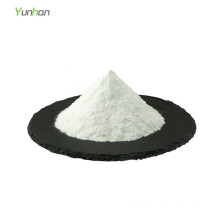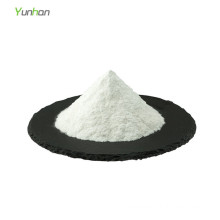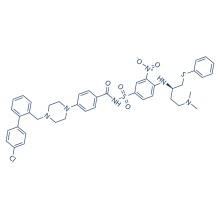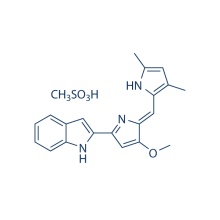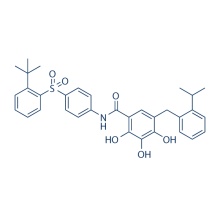HA14-1 65673-63-4
Product Description
.cp_wz table {border-top: 1px solid #ccc;border-left:1px solid #ccc; } .cp_wz table td{border-right: 1px solid #ccc; border-bottom: 1px solid #ccc; padding: 5px 0px 0px 5px;} .cp_wz table th {border-right: 1px solid #ccc;border-bottom: 1px solid #ccc; padding: 5px 0px 0px 5px;}
Molecular Weight:
409.23 HA14-1 is a non-peptidic ligand of a Bcl-2 surface pocket with IC50 of ~9 μM.
Biological Activity
HA14-1 is a small molecule and nonpeptidic ligand of a Bcl-2 surface
pocket with IC50 of approximately 9 μM. HA14-1 induces the Apoptosis of
HL-60 cells in a dose-dependent manner via caspase activation. HA14-1
shows cytotoxic effects on HF1A3, HF4.9 and HF28RA follicular lymphoma B
cell lines with LC50 of 4.5 μM, 12.6 μM and 8.1 μM respectively. HA14-1
induces apoptosis of HF1A3, HF4.9 and HF28RA cells via caspase and ROS.
HA14-1(400 nM) treatment did not have any significant effect on the
growth of glioblastoma tumors in immunodeficient mice. But HA14-1 (400
nM) increases the effect of the DNA-damaging agent etoposide (2.5 mg/Kg)
on glioblastoma growth in vivo.
Protocol(Only for Reference)
Kinase Assay: [1]
Cell Assay: [2]
Animal Study: [3]
Conversion of different model animals based on BSA (Value based on data from FDA Draft Guidelines)
For example, to modify the dose of resveratrol used for a mouse (22.4 mg/kg) to a dose based on the BSA for a rat, multiply 22.4 mg/kg by the Km factor for a mouse and then divide by the Km factor for a rat. This calculation results in a rat equivalent dose for resveratrol of 11.2 mg/kg.
Chemical Information
Molarity Calculator
Dilution Calculator
Molecular Weight Calculator
Contact us if you need more details on 65673-63-4. We are ready to answer your questions on packaging, logistics, certification or any other aspects about HA14-1 65673-63-4、65673-63-4 HA14-1. If these products fail to match your need, please contact us and we would like to provide relevant information.
Molecular Weight:
409.23 HA14-1 is a non-peptidic ligand of a Bcl-2 surface pocket with IC50 of ~9 μM.
Biological Activity
HA14-1 is a small molecule and nonpeptidic ligand of a Bcl-2 surface
pocket with IC50 of approximately 9 μM. HA14-1 induces the Apoptosis of
HL-60 cells in a dose-dependent manner via caspase activation. HA14-1
shows cytotoxic effects on HF1A3, HF4.9 and HF28RA follicular lymphoma B
cell lines with LC50 of 4.5 μM, 12.6 μM and 8.1 μM respectively. HA14-1
induces apoptosis of HF1A3, HF4.9 and HF28RA cells via caspase and ROS.
HA14-1(400 nM) treatment did not have any significant effect on the
growth of glioblastoma tumors in immunodeficient mice. But HA14-1 (400
nM) increases the effect of the DNA-damaging agent etoposide (2.5 mg/Kg)
on glioblastoma growth in vivo.
Protocol(Only for Reference)
Kinase Assay: [1]
| Affinity determination | The binding affinity of organic compounds to Bcl-2 protein in vitro is determined by a competitive binding assay based on fluorescence polarization. For this assay, 5-carboxyfluorecein is coupled to the N terminus of a peptide, GQVGRQLAIIGDDINR, derived from the BH3 domain of Bak (Flu-BakBH3), which has been shown to bind to the surface pocket of the Bcl-xL protein with high-affinity. According to our molecular modeling studies and binding measurement using fluorescence polarization, the Flu-BakBH3 peptide binds the surface pocket of Bcl-2 with a similar affinity. Bcl-2 used in this assay is a recombinant GST-fused soluble protein. Flu-BakBH3 and Bcl-2 protein are mixed in the presence or absence of organic compounds under standard buffer conditions and are incubated for 30 min. The binding of Flu-BakBH3 to Bcl-2 protein is measured on a LS-50 luminescence spectrometer equipped with polarizers using a dual path length quartz cell (500 μl). The fluorophore is excited with vertical polarized light at 480 nm (excitation slit width 15 nm), and the polarization value of the emitted light is observed through vertical and horizontal polarizers at 530 nm (emission slit width 15 nm). The binding affinity of each compound for Bcl-2 protein is assessed by determining the ability of different concentrations of the compound to inhibit Flu-BakBH3 binding to Bcl-2. |
|---|
Cell Assay: [2]
| Cell lines | HF1A3, HF4.9 and HF28RA cells |
|---|---|
| Concentrations | ~25 μM |
| Incubation Time | 20 h |
| Method | The cytotoxic effects of HA14-1 against different FL cell lines are determined by the MTT assay. Briefly, the cells (5000/well) are incubated in triplicate in 96-well plate in the presence or absence of HA14-1 for 20 h at 37 °C. Thereafter, the MTT solution is added to each well. After 4 h incubation at 37 °C, the optical density (OD) is measured by means of 96-well plate reader, with the extraction buffer as a blank. The following formula is used: percentage cell viability = (OD of the experiment samples/OD of the control) × 100. Sigmoidal dose-response curves are fitted to the mean cell viability plotted against log HA14-1 dose and lethal concentration 50% (LC50) values are calculated from the resulting curves using Prism 4.0 softw |
Animal Study: [3]
| Animal Models | Female Swiss nude mice bearing BeGBM xenografts. | ||
|---|---|---|---|
| Formulation | Free RPMI 1640-50% DMSO. | ||
| Dosages | 400 nM | ||
| Administration | Inject at the site of cell injection. | ||
| Solubility | 1% DMSO/30% polyethylene glycol/1% Tween 80, 30 mg/mL | ||
| * Please note that Selleck tests the solubility of all compounds in-house, and the actual solubility may differ slightly from published values. This is normal and is due to slight batch-to-batch variations. | |||
Conversion of different model animals based on BSA (Value based on data from FDA Draft Guidelines)
| Species | Baboon | Dog | Monkey | Rabbit | Guinea pig | Rat | Hamster | Mouse |
| Weight (kg) | 12 | 10 | 3 | 1.8 | 0.4 | 0.15 | 0.08 | 0.02 |
| Body Surface Area (m2) | 0.6 | 0.5 | 0.24 | 0.15 | 0.05 | 0.025 | 0.02 | 0.007 |
| Km factor | 20 | 20 | 12 | 12 | 8 | 6 | 5 | 3 |
| Animal A (mg/kg) = Animal B (mg/kg) multiplied by | Animal B Km |
| Animal A Km |
For example, to modify the dose of resveratrol used for a mouse (22.4 mg/kg) to a dose based on the BSA for a rat, multiply 22.4 mg/kg by the Km factor for a mouse and then divide by the Km factor for a rat. This calculation results in a rat equivalent dose for resveratrol of 11.2 mg/kg.
| Rat dose (mg/kg) = mouse dose (22.4 mg/kg) × | mouse Km(3) | = 11.2 mg/kg |
| rat Km(6) |
Chemical Information
| Molecular Weight (MW) | 409.23 |
|---|---|
| Formula | C17H17BrN2O5 |
| CAS No. | 65673-63-4 |
| Storage | 3 years -20℃Powder |
|---|---|
| 6 months-80℃in solvent (DMSO, water, etc.) | |
| Synonyms | |
| Solubility (25°C) * | In vitro | DMSO | 82 mg/mL (200.37 mM) |
|---|---|---|---|
| Water | <1 mg/mL ( | ||
| Ethanol | 82 mg/mL (200.37 mM) | ||
| In vivo | 1% DMSO/30% polyethylene glycol/1% Tween 80 | 30 mg/mL | |
| * <1 mg/ml means slightly soluble or insoluble. * Please note that Selleck tests the solubility of all compounds in-house, and the actual solubility may differ slightly from published values. This is normal and is due to slight batch-to-batch variations. | |||
| Chemical Name | (R)-ethyl 2-amino-6-bromo-4-((R)-1-cyano-2-ethoxy-2-oxoethyl)-4H-chromene-3-carboxylate |
|---|
Molarity Calculator
Dilution Calculator
Molecular Weight Calculator
Contact us if you need more details on 65673-63-4. We are ready to answer your questions on packaging, logistics, certification or any other aspects about HA14-1 65673-63-4、65673-63-4 HA14-1. If these products fail to match your need, please contact us and we would like to provide relevant information.
Product Categories : Apoptosis > Bcl-2 Inhibitor
Other Products
Hot Products
Astragaloside AChlortetracycline HCl 64-72-2Paclitaxel 33069-62-4Dexamethasone Acetate 1177-87-3Dinaciclib (SCH727965) 779353-01-4CHIR-124 405168-58-3Ro3280 1062243-51-9TAME 901-47-3CCG-1423 285986-88-110058-F4 403811-55-2Dabigatran (BIBR 953) 211914-51-1H 89 2HCl 130964-39-5T0901317 293754-55-9Aprepitant 170729-80-3Turofexorate Isopropyl (XL335) 629664-81-9BMS-378806 357263-13-9
